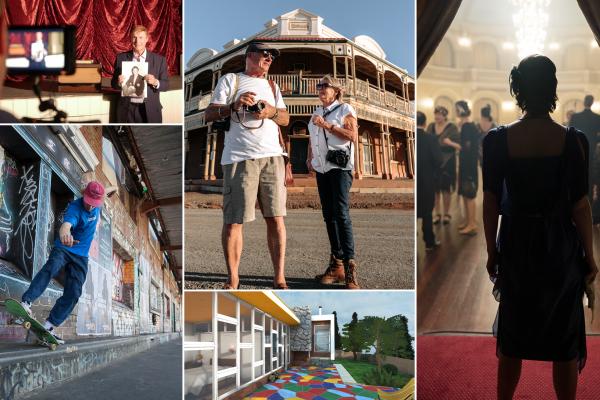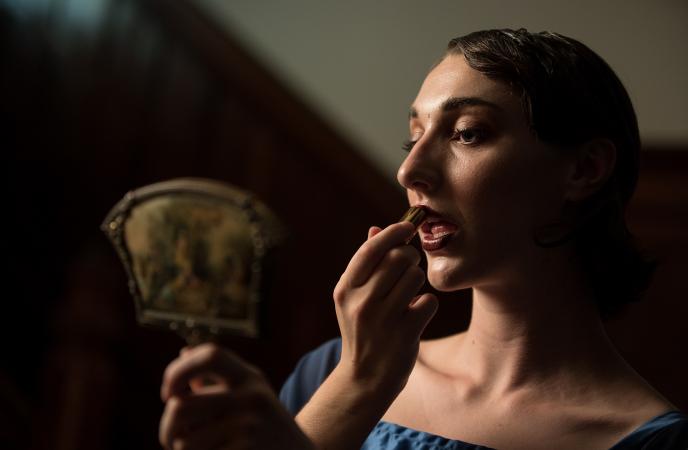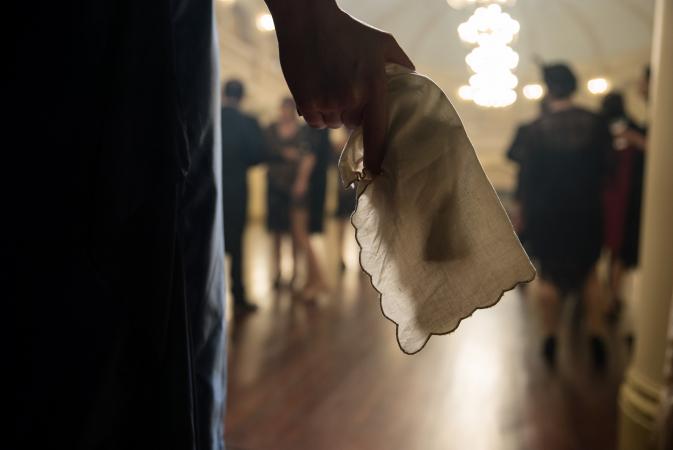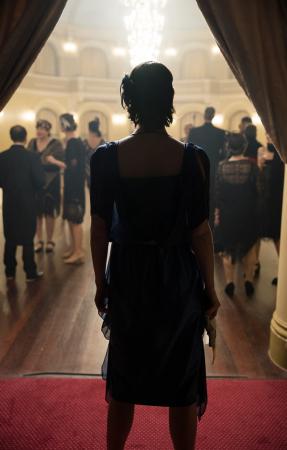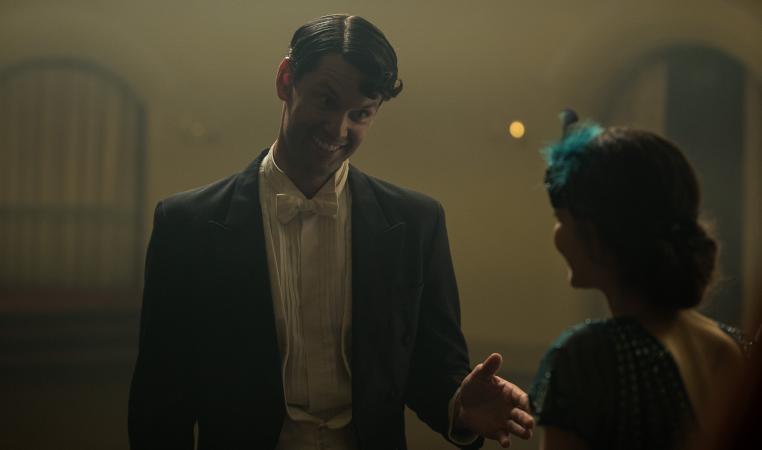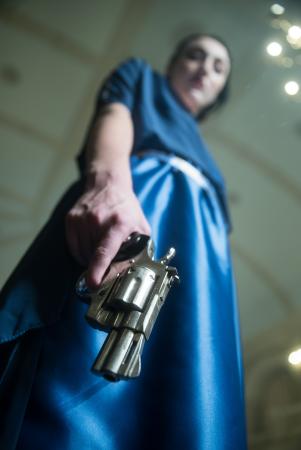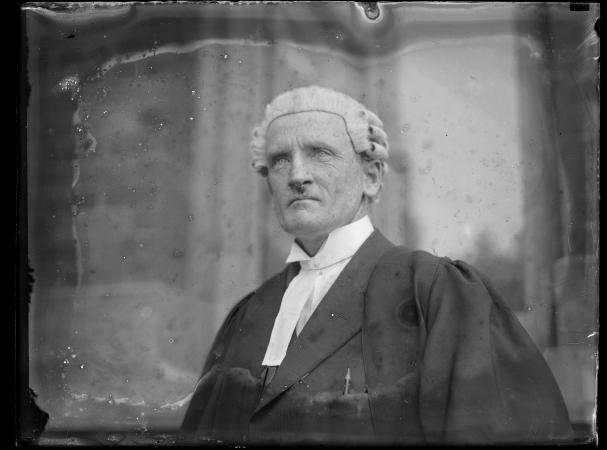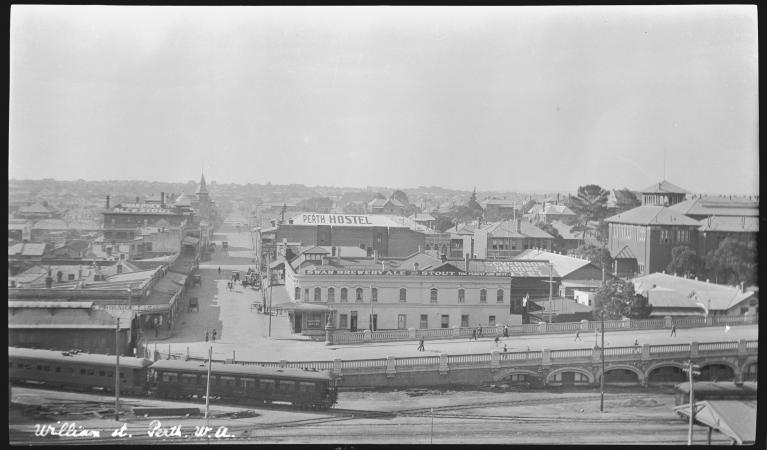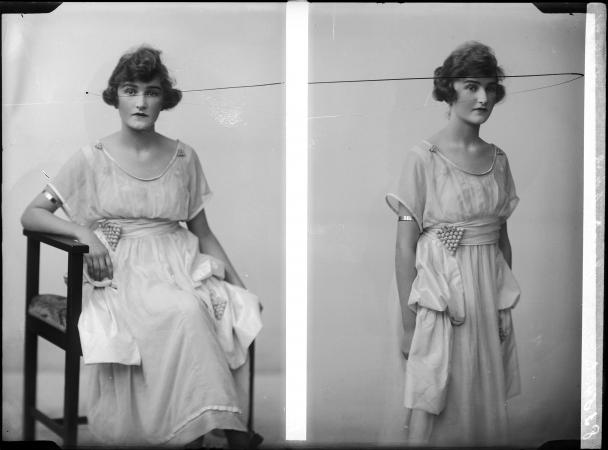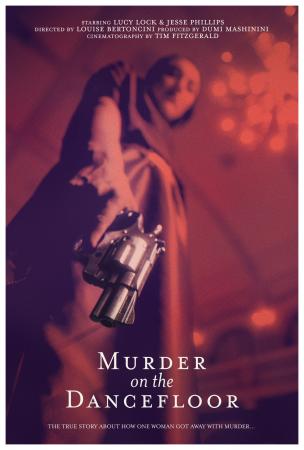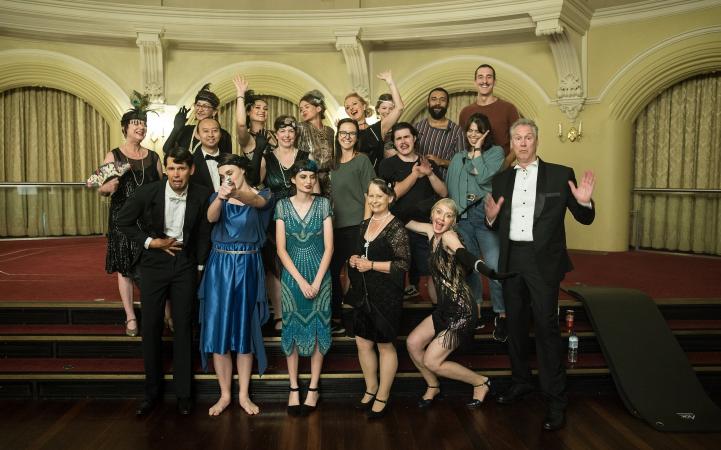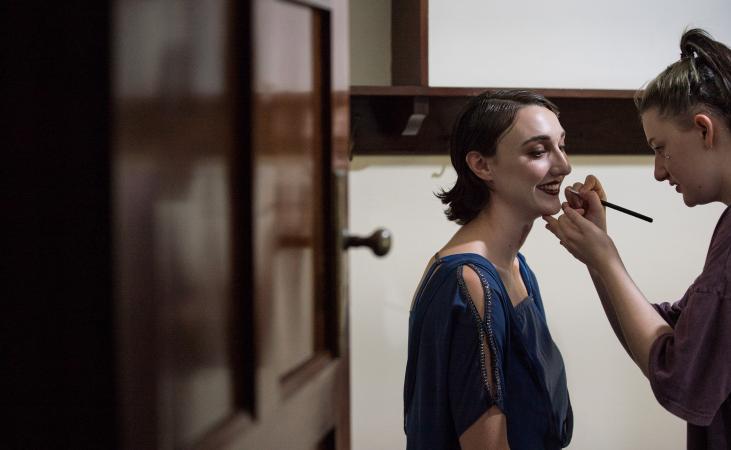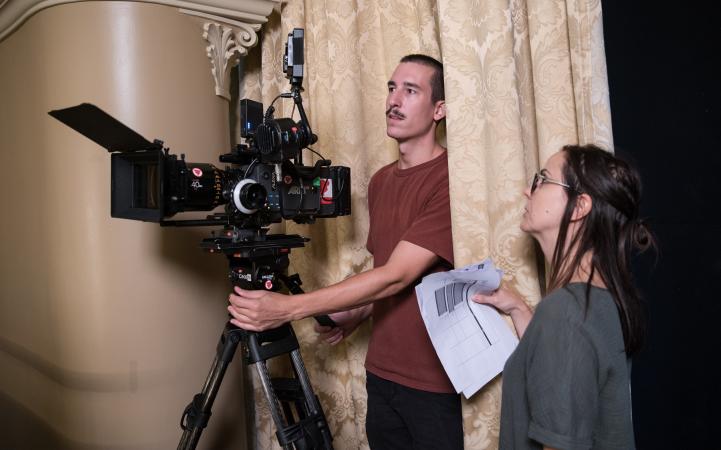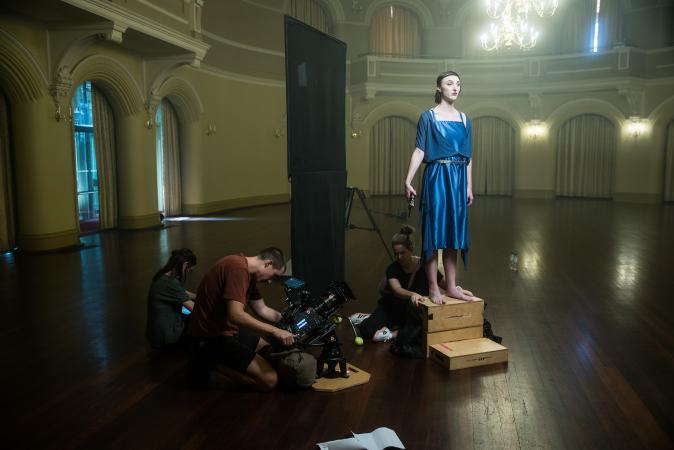Listen to the incredible case of the murder of Cyril Gidley by his spurned lover Audrey Jacob at the Government House Ballroom in 1925, brought to life in a new short film, created through the WA Reflections partnership between the State Library and Screenwest.
WA Reflections brings the State Library's collections to life through five innovative documentary short films. Filmmaker Louise Bertoncini discusses the new film ‘Murder on the Dancefloor’ with Damien Hassan from the State Records Office.
Recorded live on ABC Radio Perth on 2 July 2021.
Transcript
BEGINNING OF INTERVIEW
Christine: Let’s talk about this documentary. That details the story behind a murder that played out at the height of the roaring twenties. The records connected to the case are held by The State Record Office. There’s even a criminal file that contains the bullet linked to the murder. Let’s talk about something else for just a little bit.
Damien Hassan is the Senior Archivist from The State Records Office. Good afternoon, Damien.
Damien: Hi Christine.
Christine: Thanks for coming on. And Louise Burtoncini who was the filmmaker behind a new factual film exploring the story. Hi Louise.
Louise: Hi Christine.
Christine: You know what. I’m going to ask you how do you feel having been on hold hearing the news about lockdown ending. I know that you had the launch planned for next Thursday the 8th of July waiting to see what happens, but I assume this would be good news in the meantime Louise?
Louise: Yes, it feels like good news. I had my fingers crossed that we come out of lockdown and would be able to have our screening and it seems like that’s all happening, so it’s great.
Christine: And Damien, how did you feel hearing the news?
Damien: It’s great news, I’m sure everyone’s really quite thrilled by it.
Christine: Most people, most people are thrilled. Alright let’s talk about this. Firstly, who was... I’ll go to you Damien. Who was Audrey Jacobs? What do we know about her and Cyril Gidley. Tell us.
Damien: So, they were engaged for a spell and it didn’t go too well shall we say. So, they were engaged for a very short period, just a few months. They broke up, and then in the early hours of the 27th of August 1925, Audrey Jacob arrives at Government House ballroom. There’s a charity ball taking place that night. So, this is actually the early hours of the morning and she’s carrying a revolver and she approaches her ex-fiance Cyril Gidley and shoots him at close range in the chest with the revolver and Gidley dies within minutes.
There are so many onlookers that witnessed this spectacle that in fact police were on site. So, she must have had just incredible gumption to sort of approach the ballroom and walk in, past policemen carrying this gun and shooting Gidley. It’s just an incredible case.
Christine: [Astonishment] Wow, and what happened next?
Damien: Well, she was apprehended and she was charged with murder and it was a huge media sensation. It was 1925 and it seemed to be a very open and shut case. There was no doubt that she committed this murder and the prosecution thought they had a very clear case, but the case quickly turned upside-down and it was really due to what’s been described as the cunning of Audrey’s legal defence.
Christine: Yes, I’ve heard about this. So, what was her lawyer like?
Damien: So, her lawyer was a fellow called Arthur Haynes and we’ve actually just put a photo of him on the State Record’s Facebook so you can have a look at what he looks like because just looking at him I’m trembling just you know 100 years later. He’s just got a face that’s chiselled out of marble almost. He’s got this jaw line of a Eagle’s full forward...
Christine: [Laughs]
Damien: These piercing eyes...
Christine: He does too...wow!
Damien: They tend to just morph through you... so...
Christine: He looks like a White Walker just quietly from the Game of Thrones. He has that look about him, don’t you think?
Damien: Yes. Absolutely! So, he was described as the most vigorous and devastating cross examiner in the state. He was just someone...it was very good to have on your side, but you didn’t want to have... you know asking you questions in court.
Christine: mmm... ok so what did he do that changed the course of this case?
Damien: Well, he ran a media campaign. He was very close to a number of journalists and the media and he helped put out a story that Cyril Gidley was this dangerous and cruel man and that Audrey was really quite innocent in the whole matter so he actually played... helped you know form this narrative that Cyril Gidley got what he deserved and it’s not until recently there’s been a lot more research and examination of the archives that seems to have come to a very different conclusion that Cyril Gidley was not dangerous or violent and in fact he was in fear of his life. So, he makes out a will several months before he was shot and he also writes a note saying that Audrey Jacob had visited him and that he was in fear of his life and he left this note as proof just in case something happened to him and of course that all comes to pass.
Christine: Wow, it is 10 minutes to 3 on ABC Radio Perth in WA. Senior Archivist Damien Hassan from the State Records Office speaking there and let’s bring in filmmaker Louise Burtoncini to talk about Murder on the Dancefloor and you looked into this extensively as well Louise; the defence that was brought before the court, the proof as well. How did you feel researching this?
Louise: I mean it was just... it is one of those incredibly pieces of history where like fact is a bit stranger than fiction. It is an unbelievable story. What I found really interesting was just reading through all of the newspaper reports. There were a number of newspapers in Perth in the twenties which is an interesting thing to find out and the way that they really focussed on Audrey’s appearance and her behaviour and how they really used that to kind of flip the narrative where she was more the victim than the killer in the way that she was presented.
Christine: They made her out to be quite innocent didn’t they? Innocent...she was going to a nunnery is that right?
Louise: Yes, so it was part of the defence strategy I learnt was that it was really important to present her as a respectable, young lady by 1925 standards. So, what that means is that she had to be religious, she had to be really passive and she had to be chaste. So that was how they presented her but in reality, she was a flapper. She was a modern, young woman. She liked going out, she liked to have a drink, have a bit of a good time. So really, they were kind of suppressing the type of woman she was because it didn’t fit with this narrative that was going to give her the best chances of getting away with the crime.
Christine: And did it work?
Louise: Yes, it worked. She was... it was just a few months after she was arrested, she was released and charged with no crime and she didn’t go to jail and she left Perth shortly after.
Christine: Wow! The lawyer Arthur Hayes, I know he had quite a reputation and influence on the local papers. This is a little snippet from Murder on the Dancefloor:
“One of the most dramatic pieces of evidence was a letter written by Cyril Gidley just 10 days before his death in which he stated ‘She threatened me with my life if I didn’t make her my friend again. This note is in case she does keep her vow.’
Christine: So even that piece of evidence didn’t help Louise? Was that letter used at all?
Louise: No, so that’s the thing. They had this incredible piece of evidence that they’d found at Cyril’s residence after he died, but after Hayes was able to argue that they couldn’t confirm that that was definitely his handwriting, so it could be a forgery so then it became inadmissible which is quite creepy.
Christine: [Astonishment!] Wow, my goodness. That is just crazy! So, such an incredible story. What was it like to bring this film together? What was the process like for you Louise?
Louise: It was just fantastic. It was so great working with Adam from the State Library and with Damien from the State Records Office. They’ve got so much incredible information that I just...before this project I didn’t realise was available and so it was just so interesting doing the research and then really fun creating... we wanted to do a recreation of the night of the murder to really give a sense of you know... how the crime played out before we went into the trial so it was amazing to be able to do that in the ballroom where the murder happened. That was a really amazing thing to be able to do and to cast actors and go back and research what fashion and makeup and hair was like in the twenties so we could accurately represent that. So, it was just fantastic.
Christine: So, what records does the State Records Office have Damien? What exactly could you provide to Louise to help build this narrative?
Damien: There’s a range of records. There’s the police file that documents the whole crime and the charge. There’s Cyril Gidley’s will which he makes out several months before he is murdered. There’s the Crown Law Department file so this is... it’s quite a critical file and this is the one that contains the bullet cartridge and a program from the ball itself, so this contains the notes from the prosecution and how they were going to prosecute the case. There’s another set of records which we don’t hold which Caroline Ingram has researched at the Law Court Museum so these are Arthur Haye’s legal notes. They’re not government records. They’re private legal notes but they’ve also been absolutely critical to unpicking the truth of the whole case.
Caroline: Geez, that’s really interesting. Louise, what was most helpful for you when putting the film together?
Louise: I mean there were so many interesting things... the real tricky part was to cut this really quite big story down to a five minute film but what I found really interesting in terms of the records was obviously Cyril’s letter but then also a police report where Audrey’s parents had gone to the police because they were obviously very conservative and they were worried about her non-traditional behaviour of going to the ships and drinking and having a good time. So, they actually went to the police and filed up a formal report where they were basically saying she’s going to these ships and she’s coming back with gifts and she’s not getting them for nothing and her mother has actually said that she was afraid of Audrey because she had a bad temper.
Christine: [Gasp]
Louise: So, I found that pretty incredible to read.
Christine: That’s damning. Wow! Coming from a Mum... so let’s talk about the moral police. You, you... there were some things that you wanted to include in the documentary but couldn’t. Could you explain to us the role that police kind of played at the time?
Louise: So yes, so that’s another interesting thing that I learnt from Caroline Ingram was that there were only six policewomen working in 1925 in the police force, but they didn’t have the same job or powers as a male police officer did. They were really there to guard the morals of women rather than to kind of prevent crime. So that’s why Audrey’s parents went to see a policewoman to make this complaint or this report, which is just fascinating.
Christine: It’s a shame that they weren’t able to prevent the murder. And I still just can’t believe that he got away with it.
Nancy from Shenton Park says, “Hi Christine, some of us can feel his spirit in the Government House ballroom every time we visit”.
Why is it important to get this part of Perth’s history on screen Louise?
Louise: I mean I think it’s interesting to see Perth’s history... any Perth’s history on screen. We really don’t get to see enough of our own stories, so I think that’s what... really an important thing. But I also think it’s important that this kind of trial by media... that happens now, has been happening for so long, you know like when going over these cases, like oh yes this is how things always have been... you can really frame “the truth” to fit your objectives...
Christine: Although now you can fact check more easily thankfully [laughs] so you’re not necessarily going to be swayed by someone like Arthur or at least you would hope not and it just goes to show how important these records are as well in terms of building a story.
So, 5 minutes to 3.
Where can people see this film and when? ...is the big question Louise?
Louise: So, people can see this film next Thursday. It’s a free event at the State Library of Western Australia and we’re really lucky to have the Governor of Western Australia Kim Beasley doing an intro speech for us which we are really thrilled about and we’re going to have a Q&A after and then you can also see it at Revelation Film Festival, at Luna in Leederville.
Christine: Alright. And for anyone in the regions, we’ve got a state wide audience, is there a way that they can perhaps see it online?
Louise: Yes, so towards the end of July, it will be available online on the State Library of WA’s website.
Christine: Very good. Well, thank you so much for coming on to tell us about it. Louise, thanks for your time.
Louise: Thank you so much for having me.
Christine: Louise Burtoncini, film maker and Damien Hassan thank you as always. We’ll speak to you soon.
Damien: Ok, thanks Christine.
Christine: Senior Archivist doing all of the hard work behind the scenes from the State Records Office of WA. So that is Murder on the Dancefloor, a bit of Perth history, a 5-minute film, a factual film being put together and it launches next week.
END OF INTERVIEW

